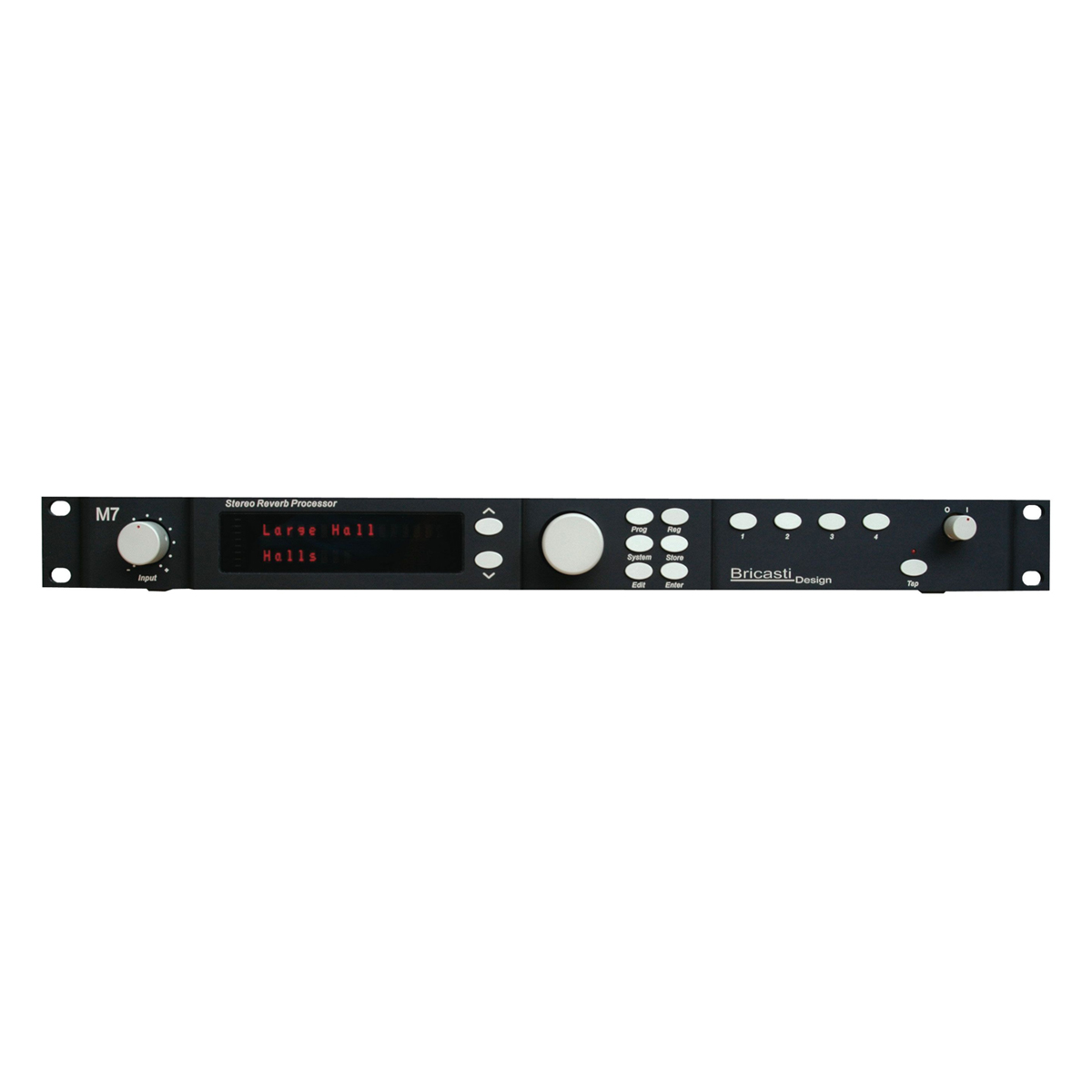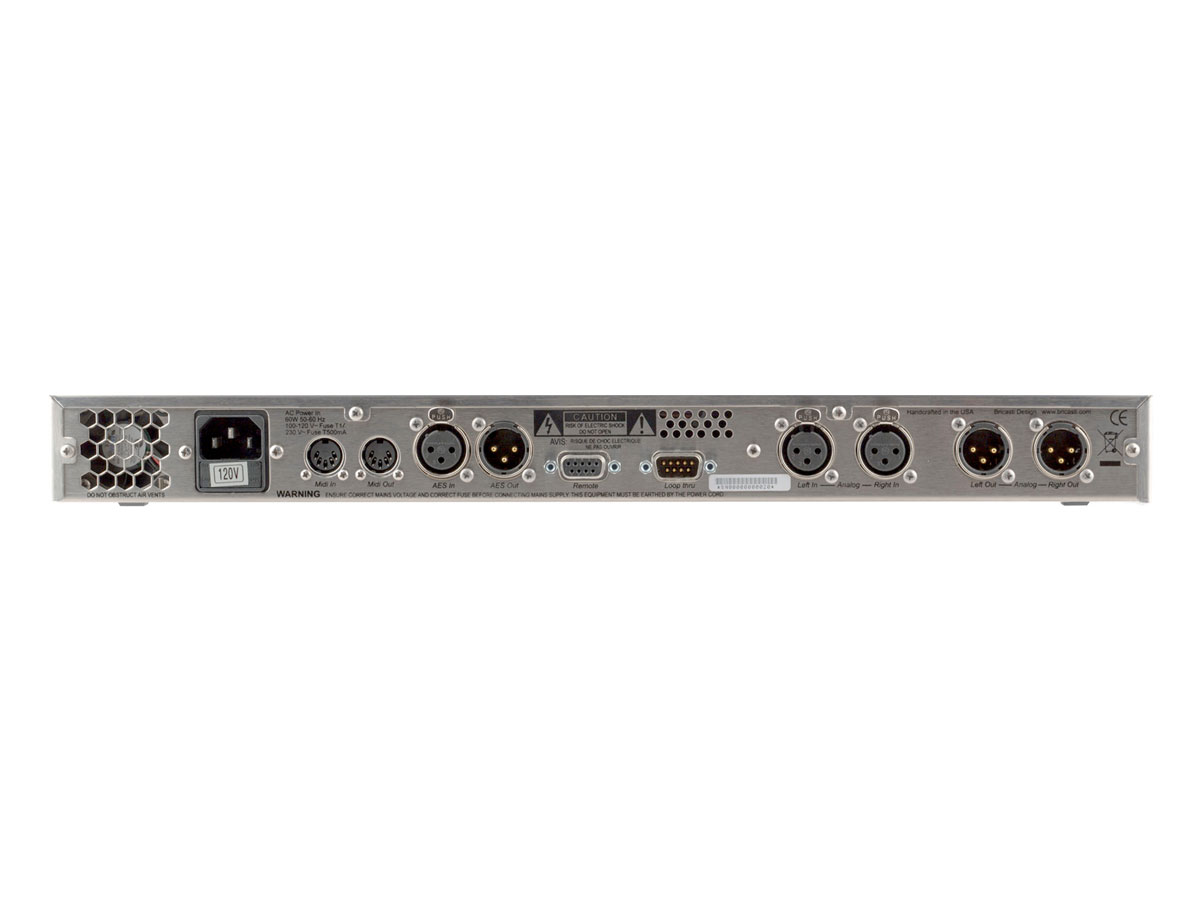Bricasti M7 Stereo Reverb Processor
Good stand-alone reverbs invariably outperform even the best plug-ins. However, this is an area where choice has always been limited, in no small part due to the hefty development costs of digital devices.
We still sell Lexicon 224’s, 224XL’s and 480L’s as fast as they arrive, as there is no substitute for the dense, wrap around sound of these classic units. Modern devices, such as the TC M4000 and System 6000 or the Lexicon 960, are pleasing and quiet but the reverb seems to float on top of the signal rather than becoming a part of it. For a variety of applications, these large mainframe reverbs are perfect but for others they come up short, particularly for drums and vocals in straight forward music recording.
Bricasti is a new company and I’m sure is an unfamiliar name to most. However, the pedigree is faultless, as the company was started by the design team responsible for developing many of the classic Lexicon units down the ages. They set out to produce a unit with the same strength of charracter as in days gone by, but with digital inputs and outputs and the most user friendly interface possible.
I’ve been impressed by the results. The Bricasti M7 is a rich, dark reverb reminscent of the classic Lexicon’s to which it owes its roots, all wrapped up in a stylish 1U rack mount unit. The editing facilities are comprehensive but logical and simple to use, and factory presets cover a wide gamut of extremely useful algorythms.
We compared our demo unit to two Lexicons – a PCM91 and a fully serviced original 224 (one of the best sounding Lexicons ever made). Allthough some of the factory presets resembled the basic programmes of the PCM91, the sound of the Bricasti was richer, with that satisfying ‘wrap around’ quality absent in most modern reverbs. Significantly, the reverb tails were smoother and more natural, and the sound lacked the ‘tizz’ of the ’91, indicative of the processing power beneath the bonnet of the Bricasti. Quite clearly this is a substantially superior unit to the `91.
It was when we A/B’d the M7 with the Lex 224 that the quality of the unit glowed through. Many of the basic presets were virtually indistinguishable. Both units had the classic full, dark sound, although the Bricasti was quieter. However, in terms of editing and facilities there was no comparison. The M7 won on every score, from the range of digital inputs to the vast range of inbuilt programmes and ability to edit every paramater.
It is rare for a new unit to live up to the claims made by the manufacturer, but the Bricasti M7 does. It really is an excellent unit that will quickly find its way into hundreds of high end music, post production and broadcast studios. If you can afford one top quality reverb and one only, this must be a prime contender, particularly as the price ticket is in fact extremely modest for what is a fabulous unit
What the manufacturer says…
The Bricasti Design Model 7 provides the highest level of musicality and ease of control imaginable in a processor dedicated to the task of reverberation. A modern high resolution digital design, utilizing a stunning array of the latest DSP processors, provides a platform for the long overdue next step in reverb processing algorithms. A separate fully differential analog section and dedicated transformer based linear power supply provide the finest analog specifications of any product of its kind. An exceptionally strong stainless steel chassis, and a tooled aluminum front panel, combine with a classic high visibility display and straight forward human interface, to complete an enduring design that is intended to fulfill its role, now and into the future.
Each design element of the Model 7 is a carefully considered statement of our vision of what the evolution of reverberation processing in its most classic form can be. With a deep appreciation of the best designs which precede it, and a passion for moving the science of reverberation forward, the Model 7 provides a palette of sounds that encompass the familiar as well as new expressions in the art. Listen to the new reference in reverb processing; it will bring new life to your art, in a way unimagined by any process before it.
Specifications
Programs and User Interface Features
- 100 Unique reverb presets
- Revolutionary new reverb algorithm True Stereo Reverb Process
- Classic and new Presets; Halls, Plates, Rooms, Chambers, Ambient Spaces
- 12 Parametric Program Parameters
- 100 User registers
- 4 Front panel “Favorites” for quick saves and compares
Hardware Design Features
- Dual Dedicated Power Supplies
- Custom design toroidal transfomer linear supply for analog
- High performace switching supply for digital
- Separate Digital and Analog modules
- Non corrosive Stainless Steel chassis and top cover
- Milled anodzied aluminum front panel, knobs and button caps
- Postive feel 2 db stepped analog input level control
- MIDI I/O
- Hand Crafted in the USA
Digital Section Design Features and Performance (preliminary)
- AES 24 Bit Digital I/O
- AES single wire 192k supported
- Self-clocking to incoming sample rates 44.1k to 192k
- 6 State of the art dual core Analog Devices DSPs
Analog Section Design Features and Performance (preliminary)
- < 20 Picoseconds Jitter
- Input level adjustable in 2 dB steps
- Balanced XLR analog I/O
- 24-bit conversion
- Dual D/A
- Fully-balanced, DC-coupled analog input and output circuits
Analog Input A/D
- Dynamic Range >116 db, A-Weighted
- THD+N
- Frequency Response: 10 Hz – 20 kHz ± < 0.05 dB
- CMRR: > 60 dB @ = 1 kHz
- Maximum Input Level: +24 dBu
- Minimum Input Level for 0 dBFS: +4 dBu
Analog Output D/A
- Dynamic Range: > 116 dB, A-Weighted
- THD+N: < 0.001%
- Frequency Response: 10 Hz – 20 kHz ± < 0.05 dB
- Maximum Output Level: +24 dBu
- Minimum Output Level for 0 dBFS: +8 dBu
- Output impedance: 40 Ohms


